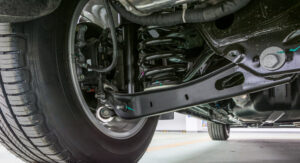Solid Axle vs. Independent Rear Suspension: The Ultimate Showdown for Strength, Comfort, and Performance

Shutterstock/Toa55
When it comes to automotive suspension systems, the debate between solid axle suspensions and independent rear suspensions (IRS) has been raging for decades. Each has its own set of strengths and weaknesses, and the choice often boils down to the vehicle’s intended use. Let’s break down the pros and cons of each setup and look at some legendary vehicles that showcase what these suspensions are capable of.
Table of Contents
Solid Axle Suspension: Built for Strength and Simplicity
Solid axle suspensions, also known as live axles, are the epitome of durability and ruggedness. They feature a single, solid beam that connects the two rear wheels, ensuring both wheels move together. This design has been a staple in the automotive world, especially in trucks and off-road vehicles, for good reason.
Pros:
- Durability: Solid axles are built tough, making them ideal for heavy-duty applications like towing, hauling, and off-roading. They can take a beating and keep on rolling.
- Simplicity: The straightforward design makes solid axles easier and cheaper to maintain. Repairs are typically less complex compared to IRS setups.
- Off-Road Performance: When navigating uneven terrain, the solid axle’s ability to keep traction on both wheels is a huge advantage. This is why it’s the go-to for hardcore off-road rigs.
Cons:
- Ride Comfort: Solid axles don’t handle bumps as gracefully as IRS setups, leading to a rougher ride, especially on paved roads.
- Handling: The lack of wheel independence can compromise handling, particularly in high-speed cornering situations.
- Weight: Solid axles are heavier, which can negatively affect fuel efficiency and overall vehicle performance.
Cool Vehicles with Solid Axles: The Jeep Wrangler is a perfect example of a solid axle vehicle that thrives off-road. Its solid front and rear axles make it a beast on rocky trails and steep climbs. Similarly, the Ford F-250 Super Duty, known for its towing and hauling prowess, relies on a solid rear axle for maximum strength and durability.
Independent Rear Suspension: Precision and Comfort
Independent rear suspensions (IRS) allow each rear wheel to move independently of the other. This design is common in sports cars and modern SUVs, where handling and ride quality are prioritized.
Pros:
- Ride Comfort: IRS excels at absorbing bumps and vibrations, resulting in a smoother, more comfortable ride.
- Handling: With each wheel operating independently, IRS provides superior traction and stability in corners, making it ideal for performance-focused vehicles.
- Weight Distribution: IRS setups are often lighter than solid axles, which can improve fuel efficiency and handling.
Cons:
- Complexity: The design is more intricate, leading to higher repair and maintenance costs.
- Off-Road Limitations: While IRS is great on the road, it’s not as rugged or durable as a solid axle for extreme off-road use.
- Cost: Vehicles with IRS are often more expensive to manufacture, and this cost can be passed on to the buyer.
Cool Vehicles with IRS: The Chevrolet Corvette is a prime example of a car that benefits from IRS. Its precise handling and smooth ride are key to its performance on both the track and the street. On the SUV side, the Toyota 4Runner has recently adopted IRS in some trims, offering a blend of off-road capability and on-road comfort.
Which Suspension Reigns Supreme?
Choosing between solid axle and IRS depends on how you plan to use your vehicle. If you’re an off-road enthusiast or need a workhorse for towing and hauling, a solid axle suspension will likely serve you better. However, if you prioritize ride comfort, handling, and road performance, IRS is the clear winner.
At the end of the day, both suspensions have their place in the automotive world. From the trail-conquering Jeep Wrangler to the corner-carving Chevrolet Corvette, these systems prove that it’s not about which is better—it’s about what’s right for you.









